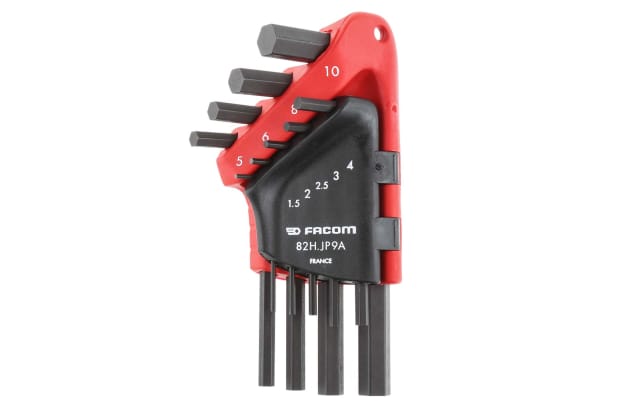- Published 28 Mar 2024
- Last Modified 26 Mar 2025
- 7 min
The Complete Guide to Hex Keys
This guide looks at what hex keys are, how they’re used and what sets are currently available on the market for a range of job and project requirements.

What Are Hex Keys?
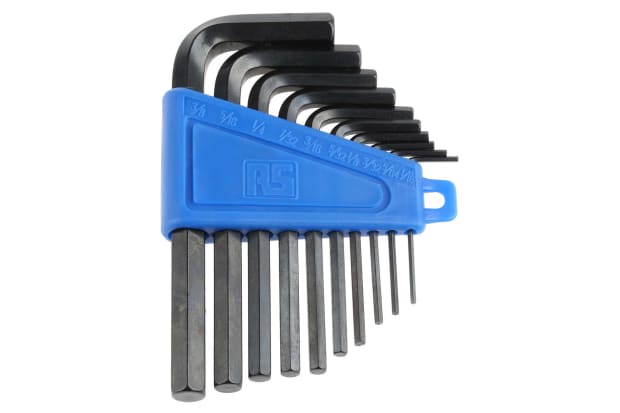
Hex keys, commonly known as Allen keys or Allen wrenches, are simple yet essential hand tools in the spanner and socket family. They are used for tightening and loosening hexagonal bolts and other compatible fasteners. Typically hex keys are a single piece of steel shaped into an L, though various designs and formats are available.Understanding the types of Allen key can help you select the right tool for different applications.
Who Invented Hex Keys?
The hex key design dates back to the late 1800s, but it was William G. Allen of the Allen Manufacturing Company in Connecticut who first patented a method for producing hex socket screws in 1910. Marketed as "safety screws," these fasteners became widely used in industrial settings due to their headless design, which reduced snagging hazards on production lines.
While the Allen key gained traction in factories early on, it wasn’t until World War II and the subsequent industrial boom that hex keys became a common household tool. Today, they are known by various names worldwide — such as "brugola" in Italy and "INBUS" in Germany — depending on the companies that helped popularise them in each region.
Are Hex and Allen Keys the Same Thing?
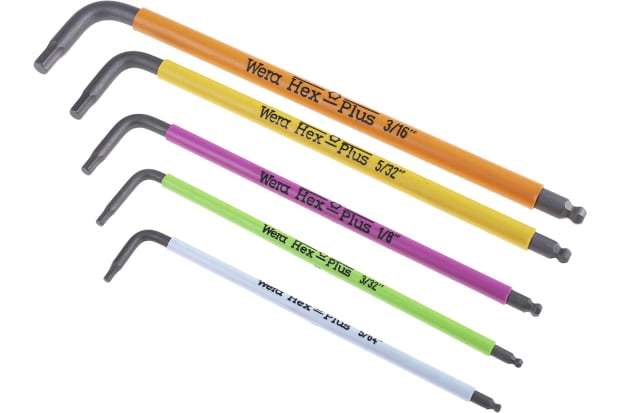
Yes, hex keys and Allen keys refer to the same tool. The term "hex key" is the generic name, describing its hexagonal shape, while "Allen key" originates from the Allen Manufacturing Company, which trademarked the name.
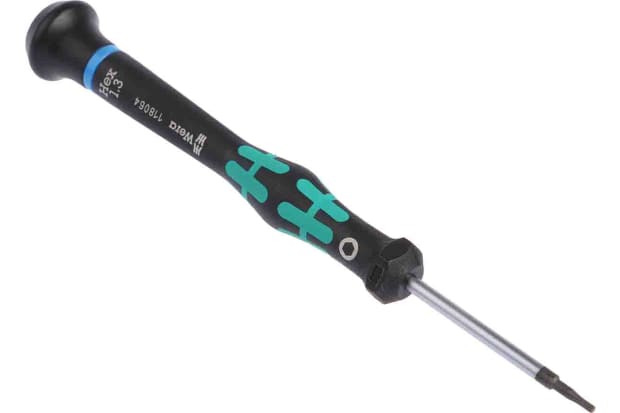
Over time, "Allen key" became a widely accepted term, much like how "Hoover" is often used interchangeably with "vacuum cleaner." Despite the different names, both tools function identically in tightening or loosening hexagonal socket fasteners.
What Are Hex Keys Used For?

Hex keys are widely used across various industries, from furniture assembly and automotive work to precision engineering and electronics. Their compact design and ease of use make them an essential tool for both professionals and DIY enthusiasts.
A common sight in flat-pack furniture, bicycles, and machinery, manufacturers often include a basic Allen key for assembly. However, investing in a high-quality set provides better durability and precision for frequent use.
Their popularity stems from several key advantages:
- Compact and lightweight – Easy to store and handle.
- Strong grip and torque – The six contact surfaces between the key and bolt head reduce slipping and stripping.
- Versatile and cost-effective – Available in different sizes and materials to suit various applications.
- Ideal for tight spaces – The L-shaped design provides better leverage and control.
- Double-ended design – Many hex keys have two usable ends, prolonging their lifespan.
- Compatible with headless fasteners – Often used in applications where a bolt lacks a traditional screw head.
In this guide, we’ll look at some of the basic types of Allen keys available to buy on the current market, as well as assessing the relative pros and cons of each, and offering a few pointers towards best practice when it comes to successful hex key sizing choices and uses.
How to Use Allen Keys?
Using an Allen key is straightforward. Simply insert one end of the tool into the recessed hexagonal fastener head and apply torque at the other end to tighten or loosen the bolt.
For most applications, the shorter arm of the hex key serves as the handle, allowing better manoeuvrability in tight spaces. However, when additional torque is required, the longer arm can be used as the handle — provided there is enough clearance to rotate the tool effectively.
Understanding how to use an Allen key properly ensures better control and prevents damage to fasteners, making it an essential skill for both professional and DIY tasks.
Types and Shapes of Hex Keys
There are various types of Allen keys available today, with many staying true to the original L-shaped design. However, some manufacturers have introduced additional features to enhance functionality and user experience. Depending on the brand and supplier, you may find specialised hex key designs, such as:
Folding hex keys
Folding hex keys function similarly to a Swiss Army knife, with multiple hex keys housed in a single foldable unit. This design is compact, portable, and helps keep different sizes organised, making it ideal for on-the-go applications. However, the trade-off is that they can be bulkier to manoeuvre in tight spaces.
Straight hex keys
Straight hex keys are a basic, single-piece design that provides a simple solution for loosening or tightening hexagonal fasteners. They are often used when additional torque is not required and are commonly found in industrial settings where precision work is necessary.
L-shaped hex keys
L-shaped hex keys are the most widely used type, offering good leverage and reach. The shorter end is typically used for applying higher torque, while the longer end provides access to recessed fasteners. They are a versatile option suitable for both professional and DIY applications.
T-handle hex keys
T-handle hex keys are designed for enhanced comfort, control, and torque, making them a popular choice among mechanics, engineers, and industrial professionals. Their crossbar handle provides a secure grip, allowing users to apply greater force with minimal strain. This makes them ideal for high-torque applications, such as automotive maintenance, industrial assembly, and mechanical repairs.
One of the key advantages of a T-handle hex key is its counterbalance effect. The additional weight of the crossbar helps seat the tool firmly into the fastener head, reducing slippage and improving stability during use. This is particularly beneficial when working with stubborn or tightly fastened bolts, where maintaining a secure grip is crucial.
However, while T-handle hex keys offer superior power and control, they are less practical for tight spaces or low-clearance areas. Unlike L-shaped hex keys, which can manoeuvre easily into recessed fasteners, T-handle designs require more space for rotation, limiting their versatility in compact environments.
To overcome this limitation, some high-end T-handle hex keys feature an adjustable sliding crossbar. This allows users to reposition the handle off-centre, making it easier to access confined areas while still benefiting from the increased torque. However, these advanced models are typically more expensive than standard L-shaped hex keys, making them a better investment for users who require frequent or heavy-duty use.
Ball end hex keys
Ball end hex keys offer greater accessibility in confined spaces by allowing engagement with fasteners at multiple angles, unlike standard flat-ended keys that require precise 90-degree alignment. This makes them ideal for automotive, machinery, and assembly applications, where bolts are often positioned in hard-to-reach areas.
Their rounded tip design significantly improves manoeuvrability, enabling users to work efficiently in narrow gaps or tight enclosures. However, the reduced surface contact between the tool and fastener can lead to faster wear compared to standard hex keys, particularly under high torque. Additionally, once worn, ball end hex keys cannot be easily reconditioned, unlike flat-ended models.
Despite these trade-offs, their versatility and flexibility make ball end hex keys a valuable addition to any toolkit, ensuring easier access to recessed fasteners and improving workflow in complex assemblies.
Click the video below to watch the RS Pro L shaped Hex Key set in action:
RS Pro L shaped Hex Key set
Hex Key Sizes
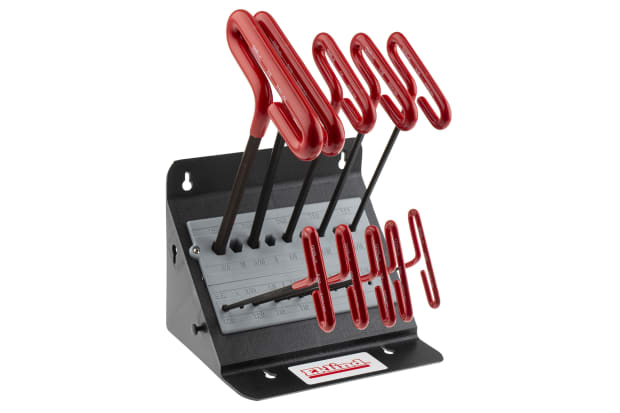
Choosing the correct hex key size is crucial for ensuring a secure fit and preventing damage to fasteners. Most reputable brands provide hex key sizing charts, either on the product packaging or at the point of sale, to help users make the right selection. While these manufacturer specifications should always be your first reference, hex key sizes are generally standardised across most brands and regions, ensuring broad compatibility.
Basic Allen key sets include a range of commonly used sizes to accommodate various hex head fasteners. More advanced sets provide a wider selection to ensure compatibility with diverse applications. Some of the most popular metric and imperial hex key sizes include:
- 1.5mm (or 1/16 inch)
- 2mm (5/64 inch)
- 3mm (7/64 inch)
- 5mm (3/16 inch)
- 6mm (7/32 inch)
- 8mm (5/16 inch)
- 10mm (3/8 inch)
- 14mm (9/16 inch)
By selecting the correct size, you can improve torque application, prevent rounding off fasteners, and extend the lifespan of both the tool and the bolt.
Imperial vs Metric Hex Keys
Note, too, that hex keys and Allen wrenches are often sold in both metric and imperial (or SAE) versions, depending on the brand, supplier and origin/purchase location. While the imperial/SAE measurements are less common these days in European countries, you’ll still find them included in some spec lists.
Understanding the difference between these measurement systems is important when selecting the correct hex key for your fastener. Using an incorrectly sized Allen key — such as a metric key on an imperial fastener — can result in poor grip, reduced torque efficiency, and potential rounding of the bolt head.
Below is a conversion chart to help match metric hex key sizes with their imperial equivalents, ensuring compatibility when working across different systems:
Metric (mm) | Imperial (inch) |
|---|---|
| 2 | 5/64 |
| 2.5 | 3/32 |
| 3 | 7/64 |
| 3.5 | 1/8 |
| 4 | 5/32 |
| 5 | 3/16 |
| 6 | 7/32 |
| 7 | 1/4 |
| 8 | 5/16 |
| 10 | 3/8 |
How Do I Measure the Size of an Allen Key, and How Can I Determine the Size I Need?
If you’re wondering how to measure the size of your Allen key — simply check the distance across the flats of the hexagonal shaft. This measurement, typically given in millimetres (mm) for metric keys or fractions of an inch for imperial keys, determines the correct fit for a fastener. To ensure compatibility, refer to manufacturer specifications or use a caliper or hex gauge for precise measurements.
If unsure, matching the key to the bolt head directly is a quick and practical method.
